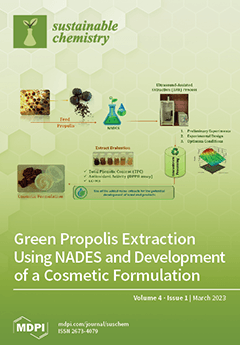The current study examines the feasibility of recycling artificially polluted wastewater that contains crystal violet (CV) organic dye by using
Azadirachta indica sawdust (AISD) waste as a highly cost-effective adsorbent. Different analytical techniques, viz., SEM/EDX, TEM/SAED, BET, XRD, TGA-DTG, point of zero charge
[...] Read more.
The current study examines the feasibility of recycling artificially polluted wastewater that contains crystal violet (CV) organic dye by using
Azadirachta indica sawdust (AISD) waste as a highly cost-effective adsorbent. Different analytical techniques, viz., SEM/EDX, TEM/SAED, BET, XRD, TGA-DTG, point of zero charge (pH
pzc), and FTIR, were used to characterize the adsorbent. Studies of batch adsorption were performed with varying contact times, starting concentrations of CV, pH levels, doses and particle sizes of AISD, and temperatures. After assessing the results using the Langmuir, Freundlich, and Temkin isotherm models, it was observed that the Langmuir model best fits the data. Various models were employed to analyze the kinetic findings, and it was confirmed that the pseudo-second-order model appears to be the most accurate. The values of ΔH° (50.01 kJ mol
−1), ΔG° (−10.254 to −5.043 kJ mol
−1), and ΔS° (182.47 J K
−1mol
−1), obtained in a temperature range of 303–333 K, revealed that the process was spontaneous, endothermic, and accompanied by an increase in entropy. Based on experimental findings and their analyses, it was concluded that the adsorbent made from AISD is one of the most effective among those obtained from domestic, agricultural, and industrial wastes. Thus, the present adsorbent can be effectively exploited to make dye-contaminated water reusable.
Full article




